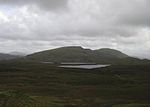Graig Ddu quarry (also known as Craig Ddu quarry, Manod quarry, or, since the closure of the nearby Cwt y Bugail quarry, Cwt y Bugail quarry) is a disused slate quarry near Blaenau Ffestiniog (formerly Blaenau Festiniog), in Gwynedd (formerly Merioneth or Merionethshire), North Wales. Although output was only about 3,000 tons a year (3,140 tons in 1882), it reputedly has 36 saw tables and the same number of dressing machines on site. As with others in the area, the quarry suffered from a lack of water, resulting in the siting of the mill some distance away, at a lower level.Slate was initially taken to a wharf on the River Dwyryd for onward transport, but in the 1860s, three inclines were built to link the quarry to the road at Tan y Manod. In 1869, this was extended by a fourth incline to connect to the Festiniog and Blaenau Railway. In 1883, the railway was replaced by a standard gauge extension of the Great Western Railway, and quarry wagons were carried piggy-back style to Blaenau Ffestiniog. The quarry was one of the first in the Blaenau Ffestiniog area to use compressed air drills for extracting the rock, and unlike most quarries in the area, all working remained on the surface until the 1920s, when underground mining began.
The quarry was known for the use of ceir gwyllt (wild cars), simple devices that allowed the quarrymen to ride down the inclines to the Tan y Manod road at the end of the day. This was possible because of the relatively shallow pitch of the inclines, but it was still a dangerous practice, and a number of workers died as a result of accidents on them.
The quarry closed in 1939, although it operated briefly at the end of the Second World War. From the 1980s, untopping of the neighbouring Bwlch y Slaters quarry began, and the operation soon engulfed Graig Ddu quarry. Currently, planning permission to extract rock ends on 31 December 2022, but Welsh Slate, the operating company, have applied for permission to continue working the site until 2048.











